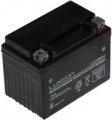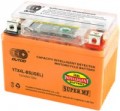Electrolyte type
Car batteries include
lead-acid, advanced
lead-acid (EFB),
calcium (Ca-Ca),
hybrid,
absorbed electrolyte (AGM),
gel, lithium-ion (Li-Ion) and
glyium-iron-phosphate (LiFePO4) batteries.. More about them:
— Lead acid. The most popular type today. In a broad sense, all modern car batteries are lead-acid, because. their design is based on a combination of electrodes made of lead compounds and an electrolyte, the role of which is played by sulfuric acid diluted with water. However, in this case, we mean the classic type of batteries that use a conventional liquid electrolyte. Their widespread use is due to their simple design and low cost, combined with good capacity and inrush currents characteristic of all lead-acid batteries (see below), as well as resistance to low temperatures (compared to other types of batteries).
— Calcium (Ca-Ca). A type of rechargeable batteries with lead plates, which are alloyed with calcium in a proportion of not more than 0.1% of the total mass of the electrode. The advantages of calcium batteries over their peers are a long service life, increased strength of the plates and their small thickness, low-maintenance or maintenance-free design. Ca-Ca batteries can easily tolerate increased voltage up
...to 14.8 V and have a low level of self-discharge. Only a deep discharge of the battery can be fatal for such models, during which the resulting calcium sulfate clogs the pores of the plates and practically does not dissolve in the electrolyte. Once discharged, a calcium battery loses up to 20% of its original capacity, which cannot be restored.
— Hybrid. Batteries with a positive electrode, which is made according to one technology, and negative — according to another. There are the following varieties of "hybrids": argentum-calcium, carbon-calcium, carbon-lead, tin-calcium, etc. Different metals are introduced into the battery structure scheme in order to ensure stable battery performance. In particular, some of them act as guarantors of the stability of the power supply to deep discharge, others are aimed at low self-discharge of the battery. The most widely used calcium "hybrids", designated by the markings Calcium Plus or Ca +. In general, hybrid batteries carry the brand of Hybrid.
— Lead-acid (EFB). An improved subspecies of lead-acid batteries with a longer operating life, a high degree of safety and a practically maintenance-free design. The abbreviation EFB stands for Enhanced Flooded Battery, which means "Enhanced Liquid Electrolyte Battery". A distinctive feature of EFB technology is thick plates made of pure lead without any impurities. The positive plates in the battery design are wrapped in special microfibre “bags” that absorb and hold the liquid electrolyte. As a result, intensive shedding of the active substance is prevented and the sulfation process is significantly slowed down when the battery is deeply discharged. And due to the homogeneous structure of the electrolyte (mixed with the natural movement of the car), the overall service life of EFB lead-acid batteries increases and the charging speed increases.
— Absorbed electrolyte. Another type of lead-acid battery is also known by the abbreviation AGM. The name itself describes the main design feature: in such batteries, the space between the plates is not filled with liquid, but with microporous plastic, which is impregnated with the electrolyte itself (an aqueous solution of sulfuric acid). This design has a number of advantages over the classical one: for example, AGM batteries do not require maintenance (see "Maintenance") and practically do not emit gases during charging (the resulting oxygen and hydrogen recombine inside the battery itself), are resistant to shaking and are well suited for start systems. -stop (see Start-stop support). Their disadvantages are high sensitivity to increased voltage during charging, the need for a special charger (ordinary ones do not fit well), as well as a high price.
— Gel. A type of lead-acid battery in which the electrolyte is not liquid, but condensed to a gel state. This design provides a number of advantages compared to the classic version (see above): more charge-discharge cycles (which means longer service life); minimum leakage of electrolyte and associated gases; no need for maintenance (see "Maintenance"); resistance to deep discharges and temperature fluctuations, etc. On the other hand, such batteries cost significantly more.
— Lithium-ion (Li-Ion). Lithium-ion technology was originally used in batteries for portable gadgets such as mobile phones, but such batteries are being used more and more recently in vehicles. Motorcycles were the first type of transport using Li-Ion technology. Among the advantages of such batteries over more traditional varieties, one can note smaller dimensions and weight, the ability to deliver high starting currents and be charged with high currents (the latter significantly reduces the charging time), as well as numerous charge-discharge cycles and a long shelf life. In addition, such batteries contain a minimum of harmful substances, do not use acids and heavy metals, and some models are even directly positioned as absolutely harmless to the environment. The main disadvantage of lithium-ion models is a very “biting” price.
— Lithium iron phosphate (LiFePO4). Such batteries are actually a modification of lithium-ion batteries (see the relevant paragraph), designed to eliminate some of the shortcomings of the original technology. First of all, they are notable for their high reliability and safety: the probability of an “explosion” of the battery during overload is reduced to almost zero, and in general, LiFePO4 can easily cope with high peak loads. In addition, they are quite resistant to cold and keep the operating voltage almost to the very discharge. The main disadvantage of this type is a somewhat smaller capacity.Starting power (EN)
Battery starting current measured in accordance with EN (Uniform European Standard). According to this standard, the starting current is the maximum current that a battery at an electrolyte temperature of -18 °C can produce for 30 seconds without a voltage drop below a certain level (for standard 12 V batteries — not lower than 7.2 V). The term "starting" appeared because this mode of operation is similar to starting the engine, when the battery has to supply a high power current to the starter for a short time.
The recommended value of the starting current is generally related to the weight category of the machine: the heavier it is, the more powerful current is usually needed to start. And many manufacturers directly indicate the recommended values \u200b\u200bin the characteristics of a particular model of transport. If the battery is bought as a replacement, then the general rule is that its starting current must be no less than that of its predecessor.
Note that in fact there may be designations of starting current according to 3 more standards: SAE (USA), DIN (Germany) and TU (GOST 959-91, Russia). The first one is practically identical to EN, while DIN and TU are quite easy to convert to EN and vice versa: they are similar to each other, and each of them gives a number approximately 1.7 times less than NE. That is, for example, to replace a battery with 200 A according to specifications, you should look for a model with a current of at least 340...A (200 * 1.7) according to EN.
Charge indicator
Has
a charge indicator on the battery.
Such an indicator displays the current charge level and allows you to generally assess the state of the battery literally at a glance, without additional actions and diagnostic equipment. In some models of serviceable batteries, the indicator can signal not only the need for charging, but also the need to add water to the electrolyte (for more details, see "Maintenance").

